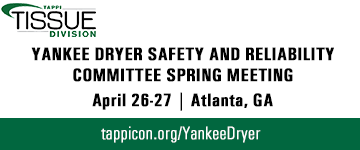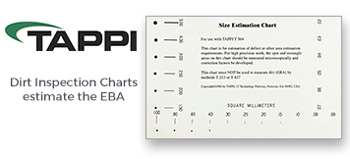 Search
Search
Use the search bar or filters below to find any TAPPI product or publication.
Filters
Content Type
Publications
Level of Knowledge
Committees
Event Type
Collections
Braiding Electrospun Nanofibers for Tendon/Ligament Tissue Engineering, 2011 Innovative Nonwovens Conference
Braiding Electrospun Nanofibers for Tendon/Ligament Tissue Engineering, 2011 Innovative Nonwovens Conference
Pre-flocculation of GCC and Clay onto NFC to Improve Strength of Filled Papers, 2013 TAPPI International Conference on Nanotechnology for Renewable Materials
Pre-flocculation of GCC and Clay onto NFC to Improve Strength of Filled Papers, 2013 TAPPI International Conference on Nanotechnology for Renewable Materials
Journal articles

Magazine articles

Characterization of the redispersibility of cellulose nanocrystals by particle size analysis using dynamic light scattering, TAPPI Journal April 2019
ABSTRACT: Cellulose nanocrystals (CNCs), which are derived from the most abundant and inexhaustible natural polymer, cellulose, have received significant interest owing to their mechanical, optical, chemical, and rheological properties. In order to transport CNC products conveniently and efficiently, they are ideally dried and stored as pow-ders using freeze-drying or spray-drying technologies. The redispersibility of CNC powders is quite important for their end use; hence, a convenient method is required to characterize the redispersibility of CNC powders. In this paper, the possibility of characterizing the redispersibility of CNC powders by particle size analysis using dynamic light scattering (DLS) was investigated by comparing the results from transmission electron microscopy (TEM) and DLS. The particle size obtained with DLS approximately matched that obtained with TEM. Compared with TEM, DLS is a quick and convenient method to measure the particle size distribution of CNCs in water. Two kinds of dispersing methods, sonication and high-speed shearing, and two kinds of CNCs prepared by different methods, sulfuric acid hydrolysis and the TEMPO (2,2,6,6-tetramethylpiperidine-1-oxyl) oxidization method, were used to study the redis-persibility of CNCs. Sonication was more efficient than the high-speed shearing method for nanoscale dispersion of CNC powders in water. CNCs prepared by sulfuric acid hydrolysis could be more easily redispersed in water than those prepared by TEMPO oxidation.
Journal articles

Magazine articles

Priorities for development of standard test methods to support the commercialization of cellulose nanomaterials, TAPPI Journal April 2019
ABSTRACT: With the growing number of producers and users of cellulose nanomaterials (CNMs), there is an increasing need to develop standard test methods to control production and quality of CNMs. In 2014, a Task Group was formed within the ISO Technical Committee 6 Paper, board and pulps to begin addressing the need for standards. This Task Group, TG 1, was tasked with reviewing existing standards and identifying the need for additional standards to characterize CNMs.In March 2018, TG 1 launched a survey to ask CNM producers around the world about the importance of having standard procedures to measure and quantify a variety of CNM properties, both physical and chemical. Producers were asked to identify the type(s) of CNM they produced and their scale of production, and to rank the properties for which they felt standard test methods were most important. In this paper, we summarize the survey responses and identify those properties of highest interest for producers of both cellulose nanocrystals (CNCs) and cellulose nano- and microfibril-based materials (CNFs/CMFs). Properties of importance can be divided into three broad groups: i) a standard has either been developed or is under develop-ment, ii) a currently used standard could be adapted for use with CNMs, or iii) no standard is currently available and further R&D and consultation with industry is needed before a suitable and well-validated standard can be developed. The paper also examines the challenges of developing new standard methods for some of the key properties—as well as the feasibility and limitations of adapting exiting standards—to CNMs.
Nanofibrous and Nanocomposite Nonwovens for Bone Tissue Engineering Applications using Human Stem Cells, 2011 Innovative Nonwovens Conference
Nanofibrous and Nanocomposite Nonwovens for Bone Tissue Engineering Applications using Human Stem Cells, 2011 Innovative Nonwovens Conference
Conference papers

Preparation of Biosilica-enriched Filler and an Example of its Use in a Papermaking Retention System, 2006 International Conference on Nanotechnology
Preparation of Biosilica-enriched Filler and an Example of its Use in a Papermaking Retention System, 2006 International Conference on Nanotechnology
Conference papers

Polymer/Nanoclay Nanocomposites for Paper Barrier Coating, 2006 International Conference on Nanotechnology
Polymer/Nanoclay Nanocomposites for Paper Barrier Coating, 2006 International Conference on Nanotechnology
Conference papers

New nanocomposite concept based on crosslinking of hyperbranched polymers in cellulose nanopaper templates, 2010 TAPPI International Conference on Nanotechnology for the Forest Product Industry
New nanocomposite concept based on crosslinking of hyperbranched polymers in cellulose nanopaper templates, 2010 TAPPI International Conference on Nanotechnology for the Forest Product Industry
Conference papers

Theory, modeling, and simulation on multiple scales for nanotechnology applications, 2010 TAPPI International Conference on Nanotechnology for the Forest Product Industry
Theory, modeling, and simulation on multiple scales for nanotechnology applications, 2010 TAPPI International Conference on Nanotechnology for the Forest Product Industry





